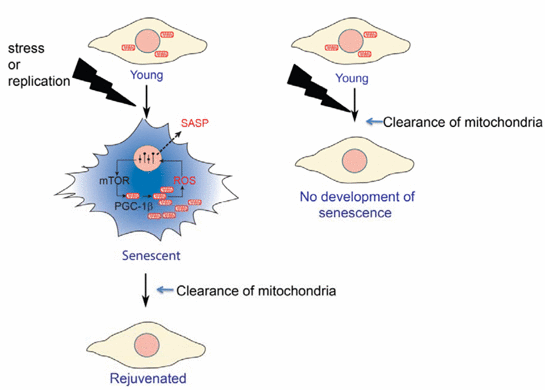|
|
Mitochondria trigger cell aging
Our cell batteries also trigger our aging!
An international team of scientists has for the first time shown that mitochondria, the batteries of the cells, are essential for ageing.
As we grow old, cells in our bodies accumulate different types of damage and have increased inflammation, factors thought to contribute to the ageing process. Cells normally eliminate mitochondria which are faulty by a process called mitophagy.
However, a team of scientists led by João Passos PhD, from the Institute for Cell and Molecular Biosciences at the Newcastle University Institute for Ageing, UK, were able to "trick" cells into eliminating the majority, if not all, mitochondria from ageing cells.
They found that when mitochondria were eliminated from ageing cells, cells became more similar to young cells. To their surprise, they observed that after losing their mitochondria, ageing cells became rejuvenated. The levels of inflammatory molecules, oxygen free radicals and expression of genes — all makers of cellular ageing — dropped to the level expected in younger cells.
This experiment is the first to conclusively prove that mitochondria are major triggers of cell ageing and brings science a step closer to developing therapies to counteract cellular ageing.
"This is a very exciting and surprising discovery. We already had some clues that mitochondria played a role in the ageing of cells, but scientists around the world have struggled to understand exactly how and to what extent they were involved.
"These new findings highlight that mitochondria are actually essential to the ageing of cells."
João Passos PhD, Institute for Cell and Molecular Biosciences, Campus for Ageing and Vitality, Newcastle University Institute for Ageing, Newcastle University, Newcastle upon Tyne, UK
The team at Newcastle University led the research, but other universities in the UK and from the US were also involved. Deciphering a new mechanism by which mitochondria contribute to ageing, together they identified that as cells grow old — mitochondrial biogenesis — the complex process by which mitochondria replicate themselves, is a major driver of cellular ageing.
The work appeared February 4, 2016 in the journal EMBO.
"This is the first time that a study demonstrates that mitochondria are necessary for cellular ageing. Now we are a step closer to devising therapies which target mitochondria to counteract the ageing of cells."
Clara Correia-Melo PhD, of the Newcastle University Institute for Ageing, and the lead author of the study.
Abstract
Cell senescence is an important tumour suppressor mechanism and driver of ageing. Both functions are dependent on the development of the senescent phenotype, which involves an overproduction of pro-inflammatory and pro-oxidant signals. However, the exact mechanisms regulating these phenotypes remain poorly understood. Here, we show the critical role of mitochondria in cellular senescence. In multiple models of senescence, absence of mitochondria reduced a spectrum of senescence effectors and phenotypes while preserving ATP production via enhanced glycolysis. Global transcriptomic analysis by RNA sequencing revealed that a vast number of senescent-associated changes are dependent on mitochondria, particularly the pro-inflammatory phenotype. Mechanistically, we show that the ATM, Akt and mTORC1 phosphorylation cascade integrates signals from the DNA damage response (DDR) towards PGC-1β-dependent mitochondrial biogenesis, contributing to a ROS-mediated activation of the DDR and cell cycle arrest. Finally, we demonstrate that the reduction in mitochondrial content in vivo, by either mTORC1 inhibition or PGC-1β deletion, prevents senescence in the ageing mouse liver. Our results suggest that mitochondria are a candidate target for interventions to reduce the deleterious impact of senescence in ageing tissues.
Synopsis
Cellular senescence serves as an important anticancer growth arrest mechanism, but also contributes to ageing. This study shows that mitochondria are necessary for:
(1) the pro-inflammatory phenotype during senescence and that senescence can be induced by mitochondrial biogenesis.
(2) Mitochondria are required for the development of the pro-oxidant and pro-inflammatory features of senescence.
(3) ATM, Akt, mTOR and PGC-1β-mediated mitochondrial biogenesis are involved in a novel senescence signalling pathway.
(4) Mitochondrial biogenesis stabilizes senescence via a positive feedback loop involving ROS and the DDR.
Reference: Mitochondria are required for pro-ageing features of the senescent phenotype. EMBO Journal. DOI: 10.15252/embj.201592862
This work was funded by the Biotechnology and Biological Sciences Research Council (BBSRC) and is part of Newcastle University's response to the challenges and opportunities presented by an ageing population.
Newcastle University is a world leader in the field at its Campus for Ageing and Vitality which is supported by the National Institute for Health Research (NIHR) Biomedical Research Centre and the location for a new £40m National Centre for Ageing Science and Innovation (NASI).
EMBO stands for excellence in the life sciences.
EMBO is an organization of more than 1700 leading researchers that promotes excellence in the life sciences. The major goals of the organization are to support talented researchers at all stages of their careers, stimulate the exchange of scientific information, and help build a European research environment where scientists can achieve their best work.
Return to top of page
|
|
|
Feb 5, 2016 Fetal Timeline Maternal Timeline News News Archive

Image Credit:Dr. João Passos laboratory, Munich, Germany
|
|
|
|



